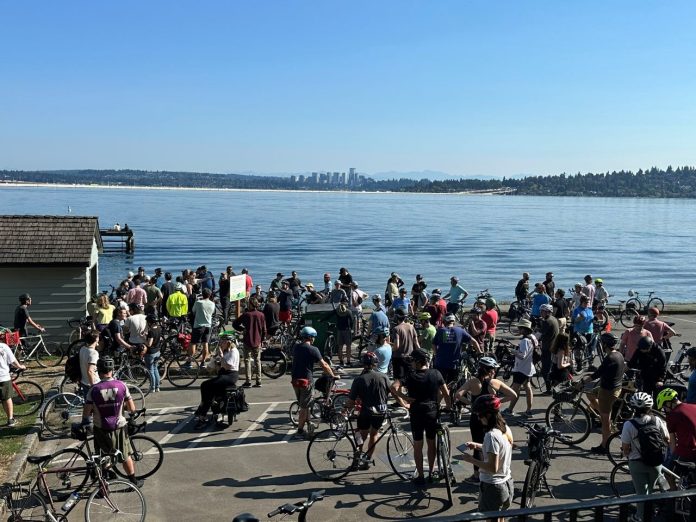
465 readers answered our call for feedback and told us how we can improve.
Last November, we asked you to complete our first-ever reader survey. Somewhat to our astonishment — and certainly to our delight — nearly 500 of you took us up on the offer, and we’ve spent the last few months poring over the results and thinking about how we want to change what we’re doing (or in some cases, keep things the same) in light of your responses.
You’ll hear more about some of the bigger changes we’re considering as we roll them out over the course of the next year, and you’ll have a chance to complete our second-annual survey towards the end of 2024 if you missed this one, but for now we wanted to take this opportunity to reflect back some of what we heard to you, our readers.
You love our transportation coverage
When we asked you what topics you wanted to read about on our site, you expressed the most interest in (in order) transportation, land use and urban planning, housing affordability, and local and state government activities — all areas we like, too — but transportation was the runaway favorite, with 71% of you listing it as one of your top two areas of interest.
This makes sense to us, as transportation is the policy area a number of our longest-standing reporters (Ryan Packer, Stephen Fesler) have covered for the longest time, and to some extent we’ve created an audience for transportation through transportation reporting. The good news is that you seem to like what you’re reading: 79% of you rated our transportation coverage as “Excellent” or “Very Good.”
You want to read more about housing, Urbanism 101, and public safety
Housing was the third-most requested topic after transportation and land use (two areas we already cover extensively), with 15% of you listing it as one of your top two interests. More on this to come over the course of the next year, we hope, but for now, a few other areas of coverage that a number of you asked for in the free-response section:
- More “Urbanism 101” type coverage that explains basic concepts in an accessible way. We’ve done this kind of stuff in the past but it could use a refresh. If you’re interested in contributing to this work, write for us!
- Public Safety coverage. Amy Sundberg has written more for us on the SPD contract lately, but many of you asked for more about how public safety and urbanism intersect.
- More stories connecting national trends to local issues. This is a bit of our bread and butter, but we can be more explicit about doing this more often.
You also asked, over and over again, for more action alerts in the stories that we do write — and although you love our wonky coverage, you asked for stories to be perhaps a little bit shorter, and perhaps a little bit less technical. We hear ya! We’ll work on this, but never fear: this is going to stay a wonky site, and there’ll always be deep dives on all our issues.
What’s next here? Despite our incredible growth over the last few years, we still only have two full-time staff, and so a lot of our coverage is capped by the degree to which we’re able to scale. That’s the bad news. The good news is that you can help us grow our coverage by either writing for us or setting up a recurring donation so that we can afford to add a third journalist to our full-time staff.
Readers skew male and White
Some takeaways from the demographics from this self-selected nonscientific survey: We got 465 responses. Of those respondents:
- 79% of respondents were cis men, 14% were cis women, 3% were trans (mostly trans women), and the remainder were genderqueer or otherwise gender nonconforming.
- 48% were 25-39 years old, 25% were 40-59, 16% were under 25, and 10% were 60+.
- 84% were white, 13% were Asian, 5% were Latinx, 3% were Black, and 2% were Indigenous.
Most of the respondents (84%) have either an undergraduate or graduate degree, while a smaller majority live in apartments or condos (56%). A plurality own their own home (48%, versus 44% who rent). Most (54%) work for a private employer, while smaller but significant shares work for the government (23%) or for a nonprofit or charity (14%).
We weren’t particularly surprised by these results; urbanism in the United States has historically been pretty White- and male-coded and dominated. That’s something we’re committed to changing, and we hope to welcome many new readers to our ranks in the next few years — while still continuing to deliver for those of you who’ve been with us for a while.
You want comments, more events, and the ability to turn off ads
We can’t say too much about this now, but we’re hoping that we’ll be able to address all three of these issues over the course of the next year. Our events program is still entirely volunteer-run, so bear with us as we scale this up and go through a transition period. And a website overhaul that might allow us to offer comments and turn off ads for subscribers is a big effort — and also one that’ll take volunteer energy and time. We’ll get there, but it won’t be immediate.
Again, we are navigating a transition from an all-volunteer effort to a professional operation. People are always stunned when they hear how few folks really are involved in making this site hum. The single biggest thing you can do to help right now is setting up a recurring donation or one-time gift to allow us to invest back in the site and continue to bring you the coverage that you’ve come to rely on. We are so grateful for you, and this site is ultimately for you, our readers.

Rian Watt
Rian Watt is vice-president of The Urbanist Board of Directors and the organization's former executive director.
